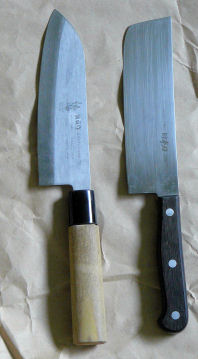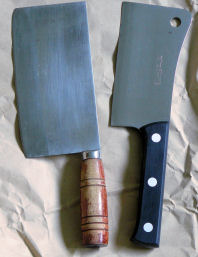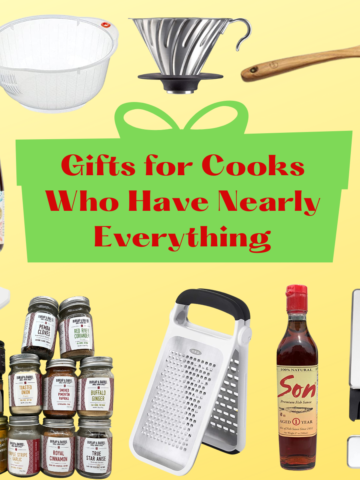There a lot of talk these days about the U.S. economy being on the verge of stumbling. The housing market hiccups, personal credit crunches, weak dollar, rising oil prices and federal budget deficit are making consumers a little skittish.
People are tightening their belts by eating out less. I've read about a couple who up until recently ate at the International House of Pancakes (IHOP) everyday. They may be jonesing for their daily pancake fix but may have to work the griddle themselves. Painful as that may sound, those folks may discover that homemade can be as good if not better than restaurant food.

I love to eat out, but at the end of the day I root for the home cook. Vietnamese food poses challenges to cooks because there tends to be a fair amount of chopping involved. Don't despair, gift yourself a few good knives this season (I always launch the holidays by buying myself something), and you'll find that they're the kind of gift that keeps on giving for years to come.
When I first moved away from home, my first serious knife was a Henckels 8-inch chef's knife, purchased from a now-defunct chain of discount stores called Adray's. I can't remember which kind it was but at the time, it was a major investment. I felt like I could conquer any culinary task placed before me. After he sold his Italian restaurant and retired, my husband's uncle, James Hoffman, gave me a well-worn cleaver (see second photo, on the left). Jim butchered his own meat so I started hacking away at chickens with that knife. I invested in one of the diamond-studded electronic knife sharpeners to keep my edge.
Those knives worked fine for me until I started work on my cookbook manuscript and was testing recipes over and over and over to get things just right. The amount of repeated prep work was astounding and I was honing my knife skills as well as my knives. What I found was that the Henckels lost its edge quickly, and the sharpening didn't help much. An article in 2005 by Los Angeles Times food writer Russ Parsons led me to try out a Japanese vegetable knife -- the lighter, thinner santoku that are popular nowadays.
As a struggling writer, I had no money for fancy blades and picked one up for $13 (above, on the left) at a restaurant supply shop in Culver City called Surfas (it wasn't as dolled up as it is now, but it's still great). That knife changed my life. The blade stayed sharp, was easy to maintain, and best of all, allowed me to chop and mince to perfection without wearing me down. It's very light.
In the past, I looked down upon such knives because they seemed so flimsy. Now I'm eating crow. That's how Asian cooks get thin slices and perfect cut without little fuss. Then I stepped up to a $19 rectangular usuba (above, on the right, what a splurge!) which doesn't have the pointy tip like the santoku. After 3 months with these Asian knives I reluctantly slipped the Henckel and a Chicago Cutlery chefs knife I'd picked up in protective sleeves and put them in a drawer. The Japanese knives took their places in the knife block.
The electric knife sharpener had a lifetime guarantee but its lifetime seemed to have past for me. My husband gifted me a steel for my birthday one year and I've used that primarily ever since. Once a quarter I have my knives professionally sharpened. In between sharpenings, all I do is lightly steel the blades and they come back nice and sharp.
Knife sharpening tip: My local knife sharpening man, Terry Beech of
Sharp Quick mobile sharpening services (if you live in the Monterey Bay, he'll come to your house if you
want!), says that if you hold the knife up with the sharp blade facing
you and you can make out the edge of the blade, it needs sharpening. It
should be so razor thin that you can't see a clean line in the blade. I also gently brush my thumb across the blade to see if it's sharp or not.

A few months ago, I semi-retired Jim's cleaver. Turns out it was a vegetable cleaver all this time. It was fine when it went through the many cheap chickens I'd bought for stock. But when I wanted to hack at pork ribs or a duck, it was no good. Terry told me that I shouldn't have been using a vegetable cleaver anyway and suggested I find a heavy meat cleaver.
The ones at the Chinese restaurant supply shops were too big and heavy for me. I wasn't about to work at a barbecue joint. In the end, I went with a cleaver made by F. Dick (stop your laughing, it stands for Friedrich Dick). A German cutlery company, F. Dick markets to chefs and commercial kitchens and they've started out in the butchering business, Terry told me. (F. Dick kitchen knives are supposedly also sold under the name Calphalon
Professional Cutlery, but I've not seen them.)
The blade is a good 3/16" thick and it weighs in just over a pound. Jim's vegetable cleaver weighs 11 ounces. The weight is important because that gives you an assist when you're striking a blow at thick bones.
At first, I ordered an 8-inch cleaver, but it was huge -- like something from a bad cartoon. The 6-inch cleaver (about $60, to the right above) felt better in my hand, though at first I felt like I was being a bit wimpy. Probably for liability reasons, the cleaver came completely unsharpened and Terry did the job for me. I used it first on a couple of free-range chickens that I bought from a local farmer and the bones cut nice and clean. Last night I needed some tomato sauce quick and took a block out of the freezer and hacked a chunk out with the cleaver. It was great -- one of the best gifts for myself that I bought this year.
Knife buying/gifting tips:
- Go for the full tang. The metal of the blade (called a tang) should go all the way through to the end of the handle. That's one of the major marks of a sturdy knife.
- There are certain knives for certain jobs but in the main, multi-purpose knife, like the santoku or usuba are fabulous. Get a few cheapie paring knives.
- Never buy a knife until you've held it. Hold the knife and see if it feels good in your hand. Price doesn't guarantee comfort. Those little ceramic steels don't cost much and work very well.
- If you gift someone a knife, it's Vietnamese custom for the recipient to give you a little money in return -- like as if they paid for the knife. Otherwise, it's considered bad luck.
- Visit restaurant supply shops (Asian and non-Asian), housewares stores like Sur la Table and Williams Sonoma. In Berkeley, try Hida Tools and Tokyo Fish Market, both on San Pablo. In San Francisco, try the Wok Shop in Chinatown, Kamei housewares on Clement, or Soko Hardware on Post in Japantown.
More info at:
- Kitchen Knife Buying Guide
- eGullet Japanese knives (discussion thread)
What are you buying yourself for the holidays?

















Von Griffing says
Discovered your blog recently by way of http://www.noodlepie.com. I finally could make caramel sauce come out right using your recipe and technique so thanks a bunch. I'm w/you on the santoku knife. Got one at Target for about $40 about 2 years ago and immediately retired my 8 in chef's knife that I paid about $80 for. That santoku is my must have kitchen item, can't cook w/o it!
Rosa says
Wow, I'd love to have such gorgeous knives!
Cheers,
Rosa
Andrea Nguyen says
Yep, these inexpensive knives are great! They're what you'd see being often used in Vietnam.
Von, glad that caramel sauce is now part of your repertoire!
Kevin says
Great post - and holy cheap-but-good knives you speak of!?
I too was a Henckel-chef-knife-kinda-guy until I picked up a Global Veg knife. What a difference. The chef's knife now does most of the all-purpose dirty work, but for most day-to-day prep, I'm reaching for the Global. I need a meat cleaver too...may be next for me. Want to be able to hack bones into bits prior to making stock.
Ashley says
Good advices about the knives. I'll buy the Santoku and the F.Dick knives. I was wondering if Andrea has advices for buying good nonstick pots/pans/skillets/heavy bottomed sauce pans. Which brands would be good to invest in? Calphalon nonstick seems very expensive to me. Thanks.
Andrea Nguyen says
Kevin, the F.Dick isn't a huge investment for a cleaver, though you can go to an Asian restaurant or supply shop and get one for about $30.
nikkipolani says
Andrea, when I'm researching 'santoku', there's so many makers of this style. The one currently sold at Surfas doesn't look like yours - I wonder if it's heavier. Is there anyone making the same style santoku as the one you have pictured?
Andrea Nguyen says
There are many santokus out there and you should check them out by touching/holding them. Yes, Surfas doesn't carry the cheapie that I bought. But the fact that such an inexpensive knife can deliver says this -- you don't have to spend too much! I imagine that what Surfas carries now is lots better than what I bought -- though what they show online are their pricey knives. When I bought those up there, they were just hanging on the rack. Sorry!
nikkipolani says
Thanks, Andrea. There're a couple of restaurant suppliers in the area; I'll check them out in person. Good to know that Surfas has more than the pricy ones online.
Affordable literature review says
well your work is pretty good and i really like your post . .every thing in the post is awesome . . . .gr8 job . . .keep sharing 🙂
Canister Set says
Chinese knives can be huge and it might not be as effective. Grip and feel the knife you want. Consider the weight too. Compact and universal might also be something for you.
#gennic[dskilbvfry] says
aCf canada goose pXa http://www.bloguinhos.com/uggsonsale22/73210/
Canada Goose says
Charity begins at home.
Monster Beats says
Nothing brave, nothing have.
Christian Louboutin says
Try (your friend) before you trust him.
marlon says
well your work is pretty good and i really like your post . .every thing in the post is awesome .